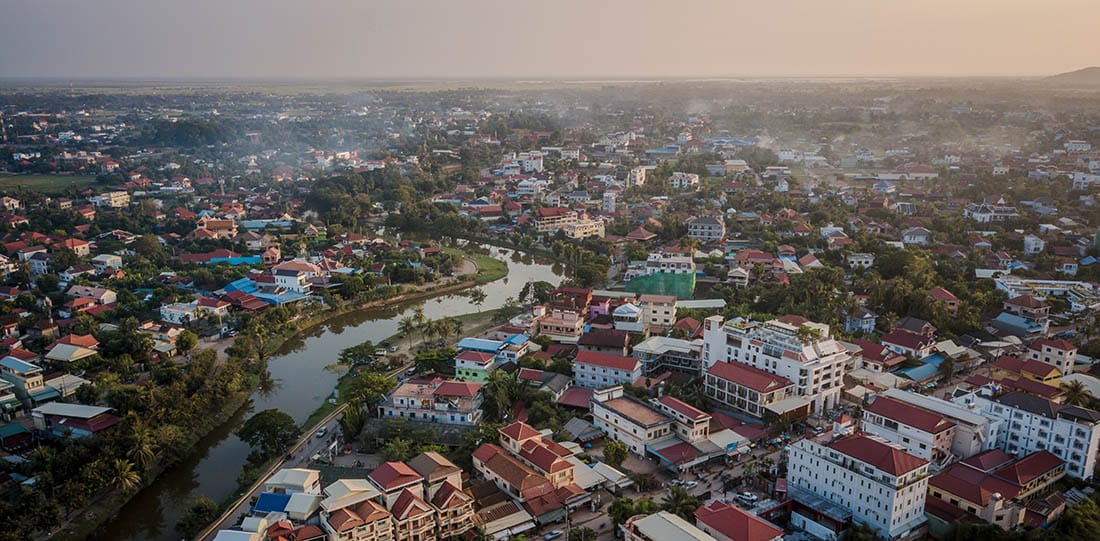Siem Reap is an exquisite destination, awash in culture and history. From its relaxed atmosphere to the world-renowned Angkor Wat temples – the largest religious monument in the world. Experience an unforgettable journey through ancient Angkor Thom and marvel at the smiling faces of Bayon Temple. Siem Reap is simply unforgettable!
Siem Reap is more than just temples, though. You’ll find bustling markets like the Old Market and the Angkor Night Market, where you can pick up some unique souvenirs and indulge in delicious Cambodian cuisine. Take a stroll down Pub Street, the heart of Siem Reap’s nightlife, where you’ll find lively bars, restaurants, and a vibrant atmosphere.
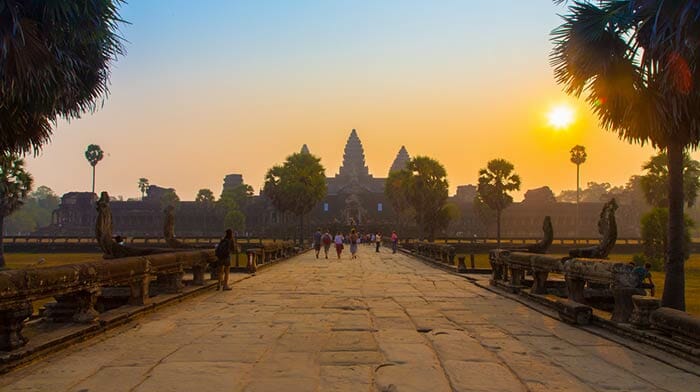
Venture beyond the town, and you’ll discover the stunning Tonle Sap Lake, a rich ecosystem that’s home to floating villages and diverse wildlife. If you’re into responsible tourism, there are numerous community-based initiatives where you can explore local villages and support the livelihoods of the people.
Siem Reap has something for everyone – whether you’re a history buff, nature lover, foodie, or party animal. With its mix of ancient wonders and modern attractions, it’s an absolute must-visit destination while in Southeast Asia. So don’t miss the opportunity to explore all that Siem Reap has to offer!
Siem Reap’s Iconic Landmarks
Angkor Wat
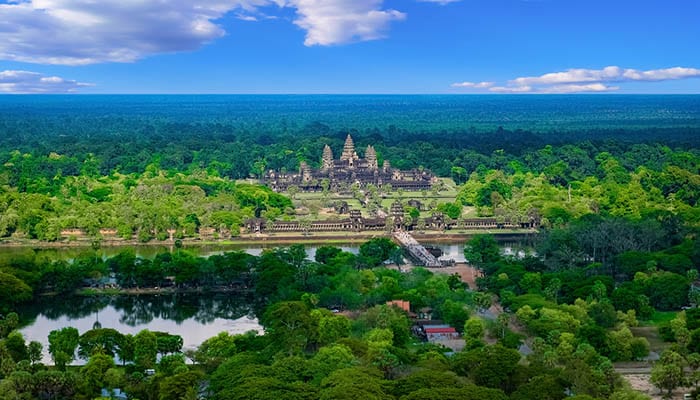
Angkor Wat, the crown jewel of Siem Reap, is the largest religious monument in the world. This ancient temple complex, built during the Khmer Empire, is a breathtaking UNESCO World Heritage site, attracting millions of visitors every year. Exploring the intricate carvings, vast galleries, and majestic towers that adorn the temple, you’ll quickly understand why it’s considered a symbol of Cambodia and features on the national flag.
Sunrise at Angkor Wat is an experience that’s not to be missed. As the sun slowly peeks above the horizon, the temple’s silhouette against the vibrant sky creates a magical atmosphere that’s sure to leave you in awe. Make sure to set aside ample time to appreciate the stunning architecture and rich history of this extraordinary place.
Angkor Thom and Bayon Temple

Angkor Thom, once the thriving capital of the Khmer Empire, is another must-see attraction in Siem Reap. This ancient city, surrounded by a massive 8-meter-high wall, is home to several impressive monuments, including the famous Bayon Temple. With its 54 towers adorned with enigmatic faces, Bayon Temple is a remarkable example of the unique Khmer style of architecture.
Wandering through the enchanting ruins of Angkor Thom, you’ll come across the Terrace of the Elephants and the Terrace of the Leper King, both of which showcase exquisite carvings and reliefs. As you explore the ancient city, take your time to appreciate its fascinating history and the craftsmanship of the Khmer people.
Tonle Sap Lake and Floating Villages
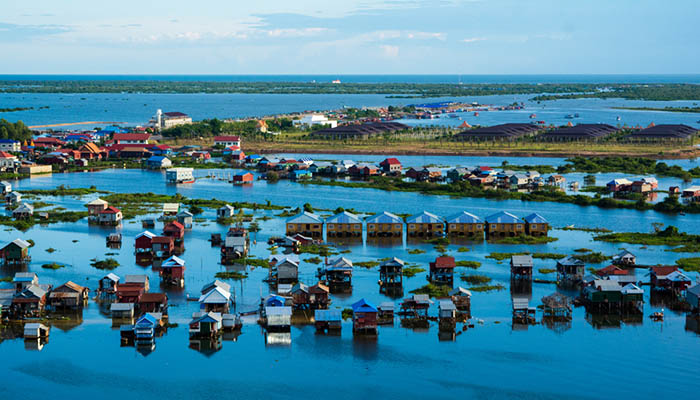
Tonle Sap Lake, Southeast Asia’s largest freshwater lake, plays a crucial role in the lives of many Cambodians who depend on it for their livelihoods. A visit to the floating villages that dot the lake’s shores is an eye-opening experience that provides a unique glimpse into the local way of life. As you meander through the villages on a traditional wooden boat, you’ll witness the remarkable adaptability of the Cambodian people, who have built entire communities on stilts to accommodate the lake’s fluctuating water levels.
Beyond the human aspect, Tonle Sap Lake is also a vital ecosystem teeming with biodiversity. It’s designated as a UNESCO Biosphere Reserve and is a haven for birdwatchers and nature enthusiasts alike. Whether you’re observing the fascinating local customs or marveling at the area’s natural beauty, a visit to Tonle Sap Lake and its floating villages is sure to leave a lasting impression.
Pub Street and Angkor Night Market

After a day of exploring ancient temples, there’s no better way to unwind than immersing yourself in the lively atmosphere of Siem Reap’s Pub Street and Angkor Night Market. Pub Street, the epicenter of Siem Reap’s nightlife, is a bustling hub of restaurants, bars, and clubs where you can sample local cuisine, sip on refreshing cocktails, and dance the night away.
A stone’s throw from Pub Street, you’ll find the Angkor Night Market, an open-air shopping paradise that comes alive as the sun sets. Here, you can visit many stalls with Khmer crafts, special souvenirs, and clothes. Be sure to hone your bargaining skills, as haggling is part of the shopping experience in Cambodia. Between the vibrant energy of Pub Street and the treasure trove of Angkor Night Market, you’ll be captivated by Siem Reap’s dynamic nocturnal scene.
Exciting Activities and Experiences to Enjoy in Siem Reap
Experience Traditional Apsara Dance Performances

While in Siem Reap, one mustn’t miss the opportunity to witness the mesmerizing Apsara dance performances. A classical Khmer art form, Apsara dance dates back to the Angkorian era and is deeply rooted in Cambodian culture. The elegant dancers, adorned in vibrant silk costumes and intricate golden headdresses, gracefully move to the rhythm of traditional Khmer music, telling stories of ancient myths and legends. Many restaurants and cultural venues in Siem Reap offer these enchanting performances, often accompanied by a sumptuous dinner featuring local delicacies.
Embark on a Culinary Adventure
Siem Reap’s culinary scene is as diverse as it is delicious, offering a tasty array of local and international dishes. To truly appreciate the flavors of Cambodia, join a cooking class and learn how to prepare authentic Khmer cuisine from experienced local chefs. From sourcing fresh ingredients at bustling markets to mastering traditional techniques, you’ll delve deep into the culinary heritage of the region. Enjoy the food you made, and learn more about Cambodian culture.
Unwind with a Khmer Massage

After a long day of sightseeing, treat yourself to a relaxing Khmer massage, an ancient healing practice that has been passed down through generations. Combining acupressure, stretching, and gentle kneading, Khmer massage techniques help to ease muscle tension, improve circulation, and promote overall well-being. Siem Reap is home to numerous spas and massage parlors, ranging from budget-friendly to luxurious, where you can experience this rejuvenating therapy and leave feeling revitalized.
Traveling to Siem Reap
Bangkok to Siem Reap
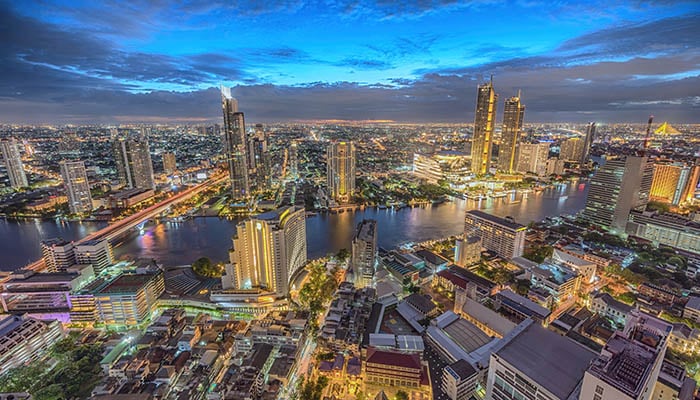
Tourists visiting Bangkok often consider a side trip to Siem Reap, Cambodia, home to the magnificent Angkor temples. There are several options to travel the 400 kilometers (250 miles) between the two cities. Flying is the quickest but most expensive option, with airlines such as Bangkok Airways, Thai Airways, Cambodia Angkor Air, and Thai AirAsia servicing the route. The flight takes around one hour, and travelers can obtain a Cambodian tourist visa upon arrival.
Alternatively, travelers can take a bus from Bangkok to Siem Reap. There is a direct bus from the Mo Chit Northern bus terminal in Bangkok that takes passengers to the border at Aranyaprathet, where they can obtain a Cambodian visa and continue on to Siem Reap. While not the cheapest option, this direct bus service offers convenience and less hassle. To learn more about the various travel options, read our comprehensive guide on traveling from Bangkok to Siem Reap.
Ho Chi Minh City to Siem Reap

Traveling from Ho Chi Minh City to Siem Reap is a popular route for tourists exploring Southeast Asia. Covering a distance of roughly 460 kilometers (290 miles), travelers have two main options: flying or taking a bus. Flying takes less than 1.5 hours but is more expensive. Airlines offering this route include Vietnam Airlines, Cambodia Angkor Air, and Lanmei Airlines. The departure airport is the busy Tan Son Nhat International Airport in Ho Chi Minh City, while the destination airport is Siem Reap – Angkor International Airport in Cambodia.
Alternatively, travelers can opt for a bus journey, which takes between 13 and 14 hours, including stops and a bus change, usually in Phnom Penh. Border crossing and visa arrangements can add extra waiting time, so it’s best to have these sorted before your trip. Several tour companies offer this route, such as SinhTourist, Mekong Express, and Kumho Samco. Buses can either be standard seating or sleeper buses, and there are day and overnight options available. For more detailed information on flights and buses, you can read our full guide on traveling from Ho Chi Minh to Siem Reap.
Traveling from Siem Reap
As your time in Siem Reap draws to a close, the possibilities for your next adventure are truly endless. From rich history and vibrant culture to breathtaking landscapes, take the opportunity to explore all that this remarkable region has to offer. Let your wanderlust lead you towards unforgettable experiences and create lasting memories along the way. Safe travels, and may the road ahead be filled with alluring destinations and exciting adventures!
Siem Reap to Bangkok
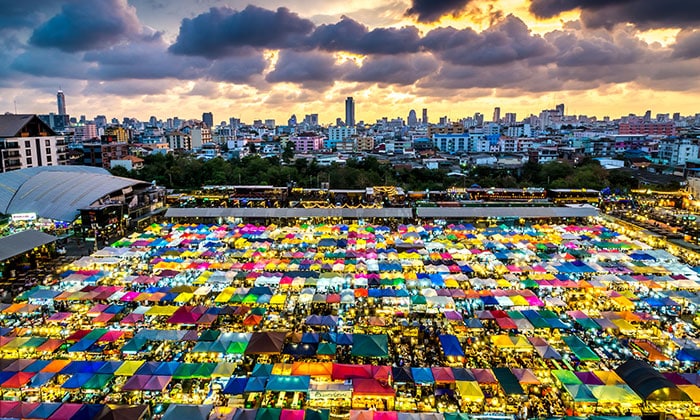
Siem Reap, the gateway to the magnificent Angkor ruins, is a popular tourist destination in Cambodia. A trip from Siem Reap to Bangkok, Thailand’s capital, is just around 400 kilometers (250 miles) away, making it a perfect extension to your cultural adventure. There are various travel options from Siem Reap to Bangkok, including flights, buses, minivans, private taxis, and trains.
Flights are the fastest and most convenient way to travel, with airlines such as Bangkok Airways, Lanmei Airlines, Thai Smile, and Thai AirAsia offering direct flights. On a tighter budget, buses and minivans are cost-effective options, with companies like Virak Buntham Express and Giant Ibis providing daily departures. Private taxis from Glassflower offer a comfortable door-to-door service, ideal for those traveling with friends or family. While taking a train is not the most convenient option, it offers a unique travel experience for those who enjoy the journey as much as the destination. For more detailed information on flights, train and buses, you can read our full guide on traveling from Siem Reap to Bangkok.
Siem Reap to Sihanoukville

After exploring the wonders of Siem Reap, consider extending your Cambodian adventure by heading south to Sihanoukville, a beautiful coastal town with attractive beaches. There are several options for traveling between these two destinations, including flights, buses, and minivans. The fastest option is to catch a flight, which takes only 50 minutes, but it’s also the most expensive choice. Several airlines offer flights between Siem Reap and Sihanoukville, making it easy to find a suitable departure.
For a more budget-friendly option, many tourists opt for bus travel, despite the lengthy 10-hour journey. Companies like Giant Ibis Transport and Virak Buntham Express offer comfortable and well-equipped buses, some with bed-like seats for added comfort. Alternatively, you can travel by minivan, which may feel more personal and can be slightly faster than buses, but may lack onboard services and could be cramped. Weigh the pros and cons of each option before deciding on your preferred mode of transportation. For a detailed overview of your choices, check out our full blog post on Siem Reap to Sihanoukville.
Did you find this guide useful?
Click on a star to rate it!
Average rating: / 5. Vote count:
